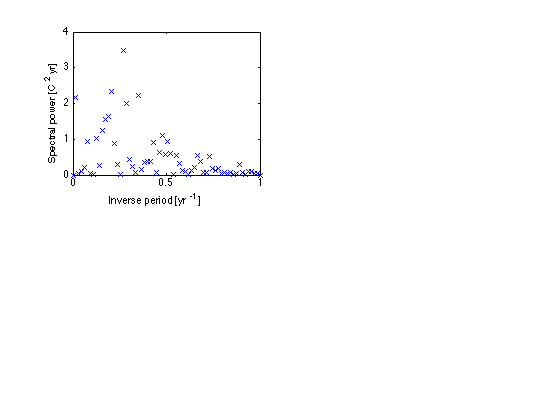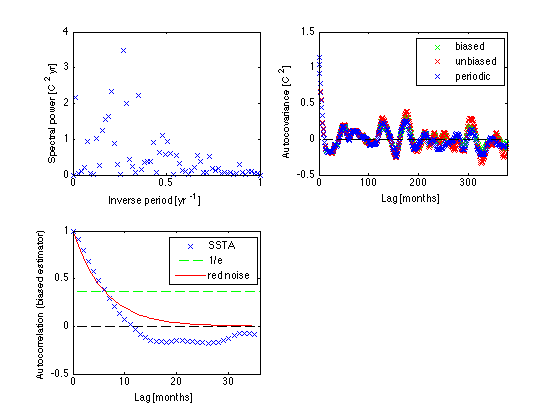Nino3.4 script 2: More power spectra, lagged autocov/corr, red noise fit
Contents
Load SSTA data and plot fraction of power in various freq. ranges
load SSTA;
N = length(SSTA);
SSTAhat = fft(SSTA);
Nyr = N/12;
M = [0:(N/2-1) -N/2:-1];
vartot = sum(abs(SSTAhat/N).^2)
varsubann = 2*sum(abs(SSTAhat(2:Nyr)/N).^2)
varfracsubann = varsubann/vartot
varfrac2to6yr = 2*sum(abs(SSTAhat(10:30)/N).^2)/vartot
vartot =
1.1450
varsubann =
1.0063
varfracsubann =
0.8789
varfrac2to6yr =
0.5421
Plot power spectrum with spectral bins measured in inverse years
subplot(2,2,1)
plot(M/Nyr,Nyr*abs(SSTAhat/N).^2,'x')
xlim([0 1])
xlabel('Inverse period [yr^{-1}]')
ylabel('Spectral power [C^2 yr]')

Calculate and plot lagged autocovariance sequence (acvs)
Three approaches
acvsb = xcov(SSTA,'biased');
acvsb = acvsb(N:(2*N-1));
acvsu = xcov(SSTA,'unbiased');
acvsu = acvsu(N:(2*N-1));
SSTAlagmx = zeros(N,N);
for lag = 0:(N-1)
SSTAlagmx(lag+1,:) = SSTA(mod((0:(N-1))+lag,N)+1);
end
covmx = cov(SSTAlagmx,1);
acvsp = covmx(:,1);
acvsp2 = ifft(abs(SSTAhat).^2)/N;
relerr_acvsp = norm(acvsp-acvsp2)/norm(acvsp2)
subplot(2,2,2)
plot(0:(N/2-1),acvsb(1:N/2),'gx',...
0:(N/2-1),acvsu(1:N/2),'rx',...
0:(N/2-1),acvsp(1:N/2),'bx',...
[0 N/2],[0 0],'k--')
xlim([0 N/2])
xlabel('Lag [months]')
ylabel('Autocovariance [C^2]')
legend('biased','unbiased','periodic')
relerr_acvsp =
5.0436e-16

Autocorrelation plot for lag < 36 months, including red-noise fit.
maxlag = 36;
subplot(2,2,3)
dt = 1;
tau = 6.1;
p = 0:(maxlag-1);
plot(p,acvsu(p+1)/acvsu(1),'bx',...
[0 maxlag],exp(-1)*[1 1],'g--',...
p,exp(-p*dt/tau),'r-',...
[0 maxlag],[0 0],'k--')
xlabel('Lag [months]')
ylabel('Autocorrelation (biased estimator)')
xlim([0 maxlag])
legend('SSTA','1/e','red noise')

Add a red noise fit to power spectrum scaled to the total variance vartot
subplot(2,2,1)
hold on
R = 1/tau;
omM = 2*pi*M/N;
dom = 2*pi/N;
ps_red = (vartot/pi)*dom*R./(R^2 + omM.^2);
plot(M(1:N/2)/Nyr,Nyr*ps_red(1:N/2),'r--')
hold off




